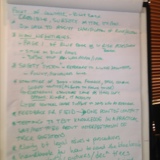Information
-
Audit Title
-
Document No.
-
Client / Site
-
Conducted on
-
Prepared by
-
Location
-
Personnel
3.0 Scope
3.0.1
-
Is this FPE applied to all Group Company vehicles and Mobile equipment?
-
Are the requirements of this element imposed by contractual arrangements on vehicles and mobile plant owned and operated by the group Company’s Contractors?
3.0.2
-
Are the operating/driving practices required by this FPE applied to all vehicles and mobile equipment operated on the Group Company facility?<br>
-
Are these same requirements applied to vehicles used solely for group Company activities outside of the facility e.g. RMX trucks?
4.0 Accountability
-
Is there a process in place for formally appointing a person or persons other than CEO to be accountable to implement and maintain each requirement
-
Has a person or persons other than the CEO been assigned accountability for implementing and maintaining each requirement of this FPE?
4.1 Hazard identification risk assessment and control
4.1.1
-
Is there a process in place to identify the competency requirements for the risk assessor?<br><br><br>
-
Have the competency requirements identified been verified against the requirements of this FPE?<br>
-
Is there a process in place to for the risk assessment and has the risk assessment in fact been undertaken?
-
Is there a process in place to identify and include each operational area in the risk Assessment?
-
Is there a process in place to identify the full range of mobile equipment which is used or may be present in each operational area (need to consider personnel transport private and company) and include these in the risk assessment?
4.1.2
-
Is there a process in place identify the local traffic rules and licensing requirements (in both local language and English) for all mobile equipment used on site and off site?<br>
-
Is there a process in place to include local compliance requirements in company traffic rules?<br>
-
Is there a process in place to include the results of the traffic flow study into speed limits, traffic directions and intersections?
-
Is there a process in place to control temporary road works?<br>
-
Is there a process in place to segregate pedestrians and vehicle traffic?
-
Are appropriate rules in place for approaching or working near operating equipment?
-
Is access to high traffic areas restricted?<br>
-
Is there a process in place to identify the general operating requirements and put them in place?
4.1.3
-
Is there a process in place for each operational area to identify high operator skill activities/requirements and have they been identified?
-
Have operational procedures been developed for these activities?
-
For each high skill activity is there a process to test knowledge and skill of operators?
-
Process in place to identify each vehicle’s Gross Vehicle Mass (GVM) as specified by the manufacturer or legal limit. Are Vehicles not loaded beyond this limit?
-
Is there a procedure in place for Journey Management plans and is it compliant with detail specified in this requirement?
4.2 Selection, Training, Competency and Authorisation
-
Is there a process in place to identify legal medical fitness requirements?
-
Have they been evaluated and appropriate standards applied?<br>
-
Is there a process in place to identify the qualification requirements for all vehicles and mobile equipment used on or off site for the Group Company’s business?
-
Is there a system/process in place to ensure that only persons who are correctly qualified operate vehicles/mobile equipment?
-
Has a training and competency assessment program been established?<br>
-
Is there a process in place to apply the competency standards for each type of vehicle and mobile equipment?<br><br>
-
Does the process address each of the competency requirements of this section of the element?
4.2.2
-
Is there a process in place to document the standards required for personnel who are authorised to train drivers and operators.
-
Do the standards require the trainer/assessors to be assessed as competent in training?
-
Do the standards require the trainer/assessor to be authorised as competent to train for each type of vehicle or mobile equipment they train personnel for?
-
Do the standards require trainer/assessors to have a least 3 years operating experience for the equipment they are training personnel to use?
4.2.3
-
Is there a training and assessment program in place to ensure personnel who maintain vehicles and mobile equipment are competent to perform that work?
-
In particular are the personnel who are performing maintenance work on vehicles and mobile equipment assessed as being competent for each type of vehicle and mobile equipment as being competent to perform work on: (Braking systems,Steering systems,Suspension systems)<br>
4.2.3
-
Is there a training and competency assessment program in place to ensure competency standards are applied for each type of Vehicle and Mobile Equipment used by Personnel?
-
Do the competencies requirements address the following functions:
-
General requirements for Vehicle and Mobile Equipment operators
-
Government licensing where applicable
-
Knowledge of company traffic rules
-
Demonstrated ability to conduct a pre-operation inspection
-
Demonstrated skills in standard operating techniques (Vehicle/Mobile Equipment application/operating procedures, start up and shut down procedure)
-
Demonstrate an understanding of the limitations of the Vehicle/Mobile Equipment in its operating environment (maximum speed, maximum incline and decline, load capacity, minimum ground/road conditions)
-
Scope of authority and responsibilities for drivers/ operators to ensure the safe operation of the vehicle, including the following obligations:<br>o ensuring all passengers wear their seat belts whilst the vehicle is being operated<br>o to ensure all personnel wear high visible clothing when working outside their vehicle or adjacent to moving traffic<br>o effects on driver capabilities in relation to alcohol, medication and fatigue
-
Demonstrate the correct actions to be taken for break downs<br>
4.2.4
-
Have the specific training requirements for hazardous vehicle/mobile equipment tasks such as (loading and dumping practices,operating vehicles in restricted areas,operating emergency vehicles) been identified and training/competency programs developed?<br>
-
Is there a training program for fatigue related issues?
-
Are vehicle and mobile equipment operators required to attend fatigue management training
4.2.5
-
Is there a training package/requirement for driver assistant/spotters in place which addresses:
-
Vision limitations of vehicles they will assist
-
The standard hand signals to be used
-
The wearing of High Visibility clothing when spotting?<br>
4.2.6
-
Is there a formal process in place to meet this requirement?
-
Does it cover each type of vehicle and mobile equipment?<br>
4.2.7
-
Is there a document and records management system?
-
Does it specifically cover these records?
-
Does it require the records to be retained for the required time frame?<br>
4.2.8
-
Are the general requirements of this FPE included in the General induction?
4.3 Communication and awareness
4.3.1
-
Do awareness and instruction programs exist for personnel who operate vehicles and mobile equipment?<br>
-
Do these programs target to address the risk exposures of different types of vehicles and mobile equipment?
-
Are the requirements of this FPE addressed in these programs?
-
Is there a schedule for instruction/awareness training
4.3.2
-
Is there a process in places to record changes, assess hazards and ensure these changes and their potential consequences are communicated to the required personnel/
4.4 Design, Purchase, Fabrication, Installation and Commissioning
4.4.1
-
Does the group Company have a design and construction specification for all roads, intersections and loading areas?<br>
-
Does it meet government specifications? If Government specifications are considered inadequate an alternative must be used e.g. ISO or EU/
-
Does the design and construction specification consider the traffic volume and types of mobile equipment which will be using the various roads on site?<br>
-
Do the design and construction specifications require the demarcation of traffic and pedestrians?<br>
-
Do the design and construction specifications require all roads to be free draining?
-
Does the design and construction specification require the installation of mandatory and advisory signs?
-
Are road sidings and parking areas provided for in the design and construction specification?
-
Is there a requirement for all roads, intersections and loading areas to be brought up to the specifications if not already.
4.4.2
-
In loading areas does the design and construction specification require :
-
Segregation of vehicles and pedestrians,
-
Lighting to a minimum of 80 lux,<br>
-
A Traffic management plan to control the movement and flow of traffic?
-
Is there a plan or program in place to bring all loading and unloading areas up to meet this specification? E.g. traffic management plan
4.4.3
-
A quarry road design specification which meets the requirements of this section of this FPE.
-
Is there a Quarry Traffic Management plan which details how the quarry will be brought up to standard and or maintained at the standard?
4.4.4.a
-
Is there a purchasing, hiring and or contracting specification which requires
-
Seat belts to be fitted for all occupants
-
Suitable access and egress for the driver/operator and passengers
-
Provision of mirrors for reversing
-
Reversing alarms?
-
Where tray backs of vehicles are used to transport people are there specifications for the fitting of seats, seatbelts and an engineered canopy?
4.4.4.b
-
Is it mandatory for bus drivers to wear a seat belt?
-
Are all company and contractor busses fitted with seat belts
-
Is it compulsory for seat belts to be worn on busses when fitted?
-
Is there a transition plan to move all busses to having seat belts for all passengers by 2015?
4.4.4.c
-
Is there a specification in place and followed which requires Light vehicles to be fitted with:
-
Driver side air bag
-
Anti-lock braking system (ABS)
-
Transition plan for all vehicles to meet this specification if they don’t already.
4.4.4.d
-
Is there a risk assessment process in place to review the purchase, hire or contract/lease of new equipment (this means new equipment to site not just unused equipment)?
-
Does this risk assessment process also consider the requirements of other fatality prevention elements?
4.4.6
-
Are OEM approved FOPS fitted to mobile equipment working in quarries?<br>
-
Have OEM approved ROPS been fitted to mobile equipment in areas with potential for rollovers
4.4.7
-
Has a formal process been established to ensure each vehicle or mobile equipment introduced into service is in a safe operating condition?
-
As part of this process have vehicle and mobile equipment specifications been established which detail the safety requirements for each type?
-
Does the process require a pre-commissioning inspection to be conducted prior to the equipment being brought into service?<br>
-
Are periodic inspections required of each vehicle/mobile equipment required as part of the process to monitor compliance to commissioning safety specifications?
-
Have formal checklists been developed which meet the requirements of this FPE?
-
Are all pre-commissioning and inspection audits required to be recorded?
-
Is there a register of all vehicles and mobile equipment approved for use on site?
4.5 Work method and condition control
-
Have standard work practices/procedures been developed to address the 5 requirements of this section of the FPE?
-
Is there a schedule for equipment inspections to be performed by drivers/operators? I.e perstart inspections
-
Is there an authorization process in place to enable personnel to operate specific vehicles/mobile equipment?
-
Is it mandatory for all drivers and passengers to wear a seat belts at times the vehicle is operating
-
Are all drivers required to comply with government/company road traffic rules at all times?
-
Is it mandatory for all loads to be safely secured?
-
Is it mandatory for all vehicles only to be loaded to OEM or Government limits whichever is the least.
-
Is it mandatory for all personnel working outside of a vehicle or adjacent to traffic to wear high visibility clothing?
4.6 Maintenance
-
Is there a maintenance program to check steering and brakes on all mobile equipment and vehicles used on site?<br>
-
Does this program meet the 5 requirements set out in this section of the FPE?
4.7 Emergency control
4.7.1
-
Has the Group Company considered what areas would be defined as “Remote areas” in their operational context?
-
Is there a monitoring system in place to track departure and arrival times for personnel travelling in remote areas?
-
Are first aid kits provided in all vehicles operating in public and remote areas?
-
Are these kits maintained on a regular basis?
-
Have likely vehicle incidents requiring an emergency response been identified?
-
Have emergency plans been developed and tested to address these likely incidents?
4.7.2
-
Have legal requirements for the transporting of these goods been identified?<br><br><br>
-
Are vehicles required to transport these goods compliant with local regulations?
-
Have personnel licensing requirements been identified?
4.8 Monitoring, inspection and audits
4.7.1
-
Is there a formal road condition monitoring process in place?
-
Are inspections conducted at least monthly?
-
Does the scope of the road monitoring meet the requirements of this section of the FPE?
-
Are all inspections recorded
-
Is an action log or equivalent generated to ensure items requiring attention are fixed?
4.7.2
-
Has a pre-operation inspection system been established for all vehicles and mobile equipment?<br>
-
Is the frequency of inspection compliant with the requirements of this section of the FPE?
-
Are the inspections recorded?<br>
-
Is there a process for reporting defects?
-
If defects are recorded is there a requirement to stand down unsafe equipment?
-
Is there a process to validate defects that have been rectified before the equipment is returned to service?
4.8.2
-
Is there a task observation system in place for activities involving vehicles and traffic?<br>
-
Are observations analyzed to determine if the safety requirements of this FPE are being applied correctly?<br>
-
Is a corrective action requirement issued for non compliance?
4.8.3
-
Is there an annual audit program for this FPE?<br>
-
Does the audit program verify the quality and effectiveness of the implementation of this FPE on site?
4.9 Reporting, assessment and corrective actions
4.9.1
-
Is there a process by which speed limits and traffic rules are reviewed annually?<br>
-
Does the review consider changes in the operating environment?
4.9.2
-
Is there a system to report hazards or defects in vehicles/mobile equipment or roads?
-
Are these defects assessed and corrective action taken?<br>
-
Do the actions required to be taken when defects/hazards are reported match the requirements of this section of the FPE?
Conclusion and auditor's comments
-
Date of audit completed
-
Signature of auditor
-
Date of auditor's signature
-
Signature of auditee
-
Date of auditee's signature











